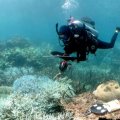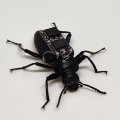The University of Queensland and the Japan Aerospace Exploration Agency (JAXA) will further develop scramjet technology in a new experiment to fly at Woomera, South Australia, in August, 2005.
UQ and JAXA officials this week signed an agreement confirming the $1.3 million HyShot 1V program, which will provide more extensive pressure and temperature measurements than previous flights.
HyShot program leader Professor Allan Paull said the new flight would be conducted at an estimated speed of Mach 7.6, or about 8000km an hour.
“The flight experiment will corroborate measurements obtained in ground test facilities at JAXA in Kakuda, Japan, and in The University of Queensland’s T4 shock tunnel in Brisbane,” he said.
Dr Katsuhiro Itoh, who is the JAXA High Enthalpy Shock Tunnel Team leader, said HyShot IV was the only hypersonics project approved this year by the agency.
“We have chosen to work with the HyShot team at The University of Queensland because we believe this offers us the best chance for success,” Dr Itoh said.
“The HyShot team is technically very experienced and well known for their success in ground and flight testing, and they can offer us an economical approach.
“Allan Paull is also an old and dear friend and we trust each other.”
Scramjets are air-breathing supersonic combustion ramjet engines. They are set to make possible two-hour flights from Sydney to London and revolutionise the launch of small space payloads, such as communications satellites, by substantially lowering costs.
UQ Deputy Vice-Chancellor (Research) Professor David Siddle welcomed the new experiment which he said was a significant example of scientists collaborating across international boundaries to further an important aerospace technology.
UQ has been at the forefront of scramjet technology development.
UQ reported for the first time in the open literature the development of a scramjet that achieved more thrust than drag in ground testing in 1993. UQ also led the international HyShot program which demonstrated the world’s first supersonic combustion in an atmospheric flight test at Woomera on July 30, 2002, at speeds of more than Mach 8, or 8 times the speed of sound.
In May, Australian and U.S. defence interests signed a $4.6 million contract to conduct a controlled scramjet experiment at Mach 10, or about 11,000km an hour, at Woomera, South Australia, in August 2005.
Partners in that project are the U.S. Defense Advanced Research Projects Agency (DARPA) and the Australian Hypersonics Initiative (AHI). Professor Paull is the technical lead for the Australian Hypersonics Initiative.
Media: Further information, please contact:
JAXA: Dr Katsuhiro Itoh, telephone +81 224 68 4799
UQ: Professor Allan Paull, telephone +61 7 3365 5653 or Jan King telephone 0413 601 248.
.jpg)


